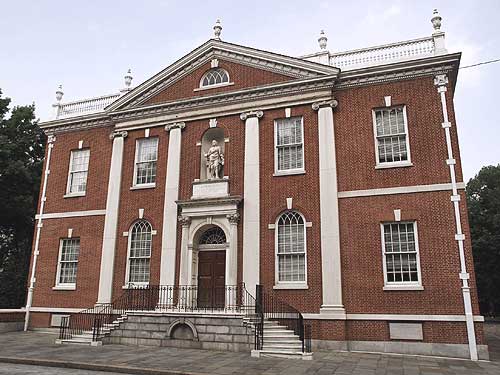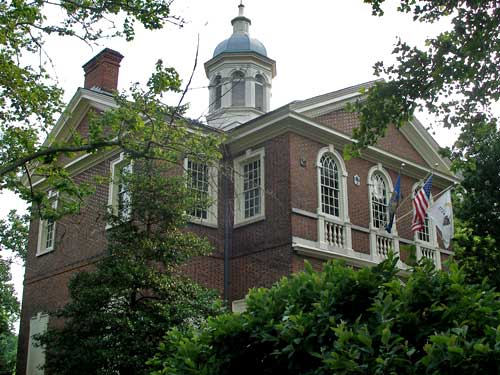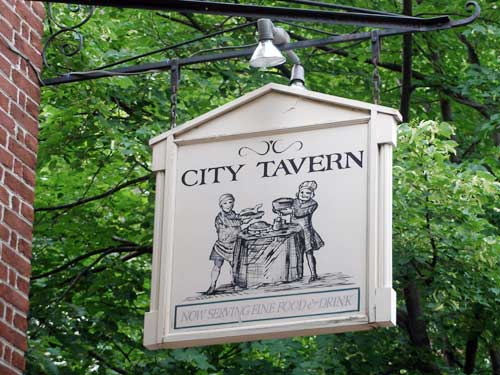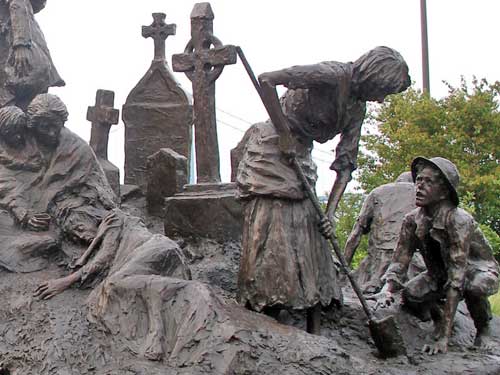My friend, Ron, and I visited Philadelphia in June 2007. Our destination was Independence National Historical Park and the many famous buildings from the American Revolution.

Approaching the city
Independence National Historical Park protects 55-acres of Philadelphia's historic district. The idea of the park began in 1915, but it wasn't until World War II had created a heightened sense of patriotism that the park was officially established in 1956.

How a simple cup of tea led to a great war...
In 1763, the British Empire won the French and Indian War (part of the Seven Years' War), which ended the long fight between France and Britain for control of North America. While this did greatly expand the empire, it also left it with a huge debt. Since the war clearly benefitted the American colonists (who had dealt with 80 years of intermittent battles with the French), Parliament felt they should have to pay part of the cost.
So in 1765, it passed the Stamp Act, which required that all legal documents and printed materials must get a stamp from a commissioned distributor, who would collect the tax in exchange for the stamp. The law applied to wills, deeds, newspapers, pamphlets and even playing cards and dice. Britain had always placed duties on trade goods, but this was the first time a direct tax had been levied. Plus, Parliament passed the act without debate. The colonists argued that “taxation without representation” was unconstitutional. When they refused to pay, violators were tried and convicted without a jury. After the British government rejected colonial petitions, protest mobs began destroying property and threatening the stamp distributors (many of whom resigned as a result) and didn't allow ships carrying the stamp papers to land. Eventually Parliament had no choice but to repeal it in 1766.
But Britain still needed money. Since the early 1700's, tea had been regularly imported to the colonies... so in 1767 they imposed a tea tax, causing the price to become quite high. In response, colonists began smuggling tea from other European markets. This, of course, put a big dent in the British tea trade. So Parliament repealed that tax, only to promptly create the Townshend Revenue Act, which along with tea also taxed glass, lead, oil, paint and paper. Since there had been a long history of duties on trade, it was expected that the colonists would readily accept the new taxes. Unfortunately, the Stamp Act had aroused resentment to all new taxes. Plus, the money raised was to used to pay for royal governors instead of allowing the colonists to have their own governors. After more boycotts and protests, the Townshend Act was repealed in 1770... on all commodities except the tea, which was retained as a symbol of Parliament’s power over the colonies.
While this helped some, there was still resistance to the tax. Some stopped drinking all together while others avoided the legally imported tea from Britain. A diminished American market left the East India Company (which played an integral role in Britain’s imperial economy) with tons of tea leaves rotting in its London warehouses. In an effort to save the struggling company, Parliament passed the Tea Act in 1773, granting the British East India Company a monopoly on the importation and sale of tea in the colonies. Not only did it undercut the business of colonial merchants, the act also kindled opposition to the tea tax. Having to purchase tea on which Townshend duties were paid, implied they were accepting Parliament's right of taxation.
The boycott was revived and resistance doubled, for the act now made allies of merchants and patriot groups. New York and Philadelphia rejected tea shipments and sent them back to Britain, and in Charleston they left the tea on the docks to rot. In Boston, however, the governor was determined to leave the ships in port, even though colonists refused them to land. So one night, in an act that became known as the Boston Tea Party, Samuel Adams and the Sons of Liberty boarded three of the ships and dumped 92,000 pounds of tea into the harbor.
Britain was outraged and passed the Coercive Acts of 1774, which colonists called the Intolerable Acts. The British repealed the colonial charter of Massachusetts and shut down Boston Harbor until the colonists reimbursed the cost of the destroyed tea. Parliament also appointed a British general as the colony's governor. Now, even moderate Americans began to believe the radical claims of British tyranny and of plans to overthrow representative government in the colonies.
The First Continental Congress was formed in the winter of 1774 to petition Britain to repeal the acts. They met here in Philadelphia at Carpenters' Hall. But the situation escalated, and in April 1775, The first shots of the Revolutionary War were fired at Lexington. In May, the Second Continental Congress assembled at the Pennsylvania State House (now called Independence Hall) and entreated King George III to prevent further conflict But the petition was rejected and the king officially declared the colonies to be in a state of rebellion. Parliament passed the Prohibitory Act in 1776, which established a blockade of American ports and declared American ships to be enemy vessels. In June, the Declaration of Independence was drafted and officially adopted on July 4. War was official. In 1790, President George Washington moved the capital from Philadelphia to Washington D.C.
Our first step back into history involved a visit to the Liberty Bell.

The 'bell house', outside...

... and inside (with a view of Independence Hall)

The State House bell (now known as the Liberty Bell) used to ring from the bell tower of Independence Hall (that it now looks out at across the street). The 2,000 pound bell was cast by the Whitechapel Foundry in London in 1753. For unknown reasons, it cracked soon after arriving in Philadelphia. Melting down the metal, local craftsmen John Pass and John Stow cast a new bell. It's not sure when the crack first appeared, but it was possibly in the early 1840's, after nearly 90 years of hard use (including ringing to signal the end of the Stamp Act). In 1846, an attempt was made to fix it by actually widening it. But when the bell was rung, a second crack appeared... silencing the bell forever.
The Liberty Bell used to be call the Independence Bell or Old Yankee's Bell, but in 1837 it was adopted by the American Anti-Slavery Society as a symbol and got its current name. Its inscription reads: "Proclaim LIBERTY throughout all the Land unto all the Inhabitants thereof".

The large fixed crack and the small hairline crack that runs from the top of the large crack up through the word "Liberty" at the top
Independence Hall was built between 1732 and 1751 as the colonial legislature for the Province of Pennsylvania. It later became the Pennsylvania State House. It was the principal meeting place of the Second Continental Congress from 1775 to 1783 and is where both the Declaration of Independence and the US Constitution were adopted.



The 40-foot tall "grandfather clock" was built in 1753 by Thomas Stretch. The original was removed around 1830 but this replica was added in a restoration in 1973.

A statue of George Washington (1732 - 1799) resides in front.
Library Hall was built in 1789 for the Library Company of Philadelphia, which was founded in 1731 by Benjamin Franklin as a subscription library supported by shareholders. Before this time, books were only owned by the wealthy and kept in private collections. Today it contains such wonderful things as original journals from the Lewis and Clark expedition, a copy of the Declaration of Independence in Jefferson's own handwriting, the Mayflower Compact and many Revolution-era pamphlets and writings.


A marble statue of Benjamin Franklin (1706 - 1790) stands above the doorway. He holds an inverted scepter, symbolizing the victory of the colonies over British rule.

Commodore John Barry (1745 - 1803) was the first captain of a US warship sailing under the Continental flag. He is often called the "Father of the American Navy."
The Tomb of the Unknown Soldier of the Revolutionary War was completed in 1957. The tomb houses some remains that were dug up back from when this area was a cemetery. They are of a soldier but it is uncertain whether he was Colonial or British. Bodies are still occasionally found during construction and maintenance projects.

The monument includes an eternal flame...

... and a bronze cast of George Washington.
The Second Bank of the US was established in 1816 to hold government deposits and regulate currency. Built from 1819 -1824, this building has been called the finest example of Greek Revival architecture in the US. It currently serves as a portrait gallery.



Robert Morris, Jr. (1734 - 1806) was born in England but became a merchant who "financed the American Revolution." From 1781 to 1784, he served as the Superintendent of Finance. He also signed the Declaration of Independence and the Constitution.


In 1774, the American colonies felt their grievances against Great Britain were being ignored. The First Continental congress met here at Carpenters' Hall to choose a course of action. They appealed to the King to repeal unjust laws and taxes, and they pledged not to trade with Britain. By the time they met again several months later, the war had already begun.

The hall itself was the meeting place for the city's master builders. They banded together to establish architectural standards, set prices for work, and help each other in times of need. Among many other things, they built Independence Hall and this building (built in 1770-74).


The garden recreated here incorporates many features of the formal gardens of the 1700's, such as neat pathways, geometric flower beds and gazebos.
The Merchants' Exchange Building, built from 1832-34, is the oldest existing stock exchange building in the US. Before then, most business had simply been conducted in the City Tavern. But as commerce and trade grew, merchants felt a need for a centralized exchange building. In 1831, a group of prominent citizens led by Stephen Girard, the nation's wealthiest man at the time, founded the Philadelphia Exchange Company.



The Corn Exchange Bank was founded in 1853 in New York but had a branch here. This building in the Georgian Revival style was built in 1900-01.
The three-story City Tavern was built in 1773 to recreated the atmosphere of a London tavern. It was a center for political discussions, business transactions, social events, and of course a place to get a good beer. It was even used as a meeting place for the First Continental Congress.


Celebrating the first anniversary of independence on July 4, 1778... although clearly equality still had a ways to go


The building was demolished in 1854 but rebuilt 1975 by the National Park Service.

Servers wore Revolutionary-era outfits.

The beers were based on original recipes from those of George Washington and Thomas Jefferson.
Penn's Landing is a spot along the Delaware River where Pennyslvania's founder, William Penn, allegedly first docked in 1682. In reality it was in the nearby city of Chester.

Penn named the city Philadelphia, which is Greek for brotherly love (from philos = love and adelphos = brother).

A tugboat passes by the Benjamin Franklin Bridge on the Delaware River.

The Irish Memorial (Leacht Cuimhneachain Na Ngael) at Penn's Landing dedicated to the memory of the over one million people who died during the potato famine in Ireland in 1845 - 1850. Another million were forced to emigrate.



Tamanend was chief of the Sakima clan in the Lenni-Lenape nation who lived in the Delaware Valley at the time Philadelphia was established. William Penn established a friendship treaty with them when he arrived. He was considered a patron saint of America by the colonists.
return • continue

